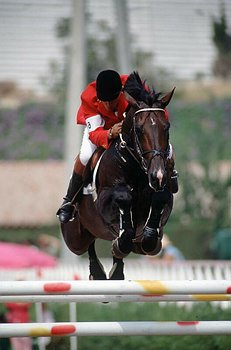 As a warmblood horse, the Belgian Warmblood is characterized not by uniformity of coat color, appearance or pedigree chart, but by uniformity of purpose. Like other warmbloods, Belgian Warmblood breeding horses are subjected to rigorous studbook selection.
As a warmblood horse, the Belgian Warmblood is characterized not by uniformity of coat color, appearance or pedigree chart, but by uniformity of purpose. Like other warmbloods, Belgian Warmblood breeding horses are subjected to rigorous studbook selection.
The most reliable way to positively identify a Belgian Warmblood is by the brand on the left thigh. Belgian Warmblood foals receive this brand during their foal inspection, when they are given a passport and deemed free of obvious defects.
Between the ages of three and four years old, Belgian Warmblood stallions are presented to a jury in a "Hengstenkeuring" or stallion licensing test. The licensing test consists of a veterinary inspection, subjective evaluation of the stallion's conformation and jumping ability without a rider, and evaluation of the stallion's qualities under saddle. Stallions that do not achieve the desired marks in the licensing test are not eligible for the studbook. To retain status in the studbook, stallions must participate in competitions for young show jumping horses called the "Classic Cycle." Mares take part in similar conformational evaluations, however judgement of a mare's qualities as a riding horse are elective.
The published breeding aim for the Belgian Warmblood reads as follows:
"A noble modern and correctly-built warmblood horse with a rectangular frame, big outlines and good basic paces. The horse should be pleasant to ride and have an unobjectionable character, so that it can be used by any rider, both as pleasure horse and as a performance horse on national and international level. There has to be a balance between conformation, performance and health."
Belgian Warmbloods range in size and substance, but the ideal size for a stallion is between 16 and 17 hands high at the withers. Mares are not eligible for breeding rights unless they exceed 15.1 hands high. In type, the Belgian Warmblood is similar to the Holsteiner, Selle Francais, Dutch Warmblood, and Hanoverian, and less like the Trakehner.
The BWP does not hold any regulations barring horses of certain coat colors; however, the most common coat colors are chestnut ("vos"), bay ("bruin"), brown ("zwartbruin"), black ("zwart"), and grey ("schimmel"). The modifier "donker" means a dark shade, "licht" means light. Modifiers on "schimmel" often indicate the horse's color at birth, for example "bruinschimmel" means a grey born bay. There are also tobiano patterned pinto ("bont") Belgian Warmbloods, though they are uncommon.
Belgian Warmbloods present a unique case in that there is no indigenous warmblood mare base. Of the 181 approved stallions listed, half were themselves Belgian Warmbloods. The remaining half were primarily Holsteiners, Selle Francais, Dutch Warmblood, or Hanoverian; there were a handful of Oldenburg, Zangersheide, Thoroughbred, Westphalian, Belgian Sport Horse and Rhinelander stallions as well.
Of the Belgian stallions, about a quarter had a Belgian sire. Another quarter had a Selle Francais sire, while a further 42% had Dutch, Holsteiner, or Hanoverian sires. The remaining sires were Westphalian, Rhinelander, Swedish, Belgian Sport Horse, Oldenburg, or Thoroughbred.
